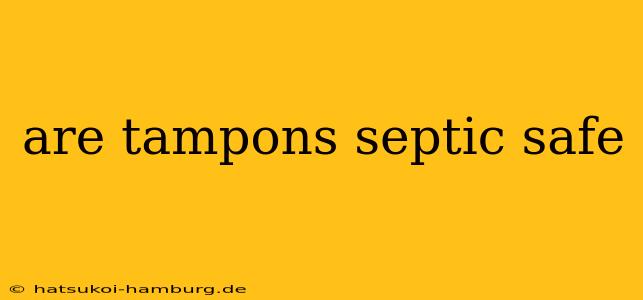Tampons are a common menstrual product, but questions arise about their compatibility with septic systems. This article will explore the safety and impact of flushing tampons down the toilet, focusing on septic system health and environmental considerations.
What Happens When You Flush Tampons?
Unlike toilet paper, tampons are not designed to readily break down in water. They're made of absorbent materials like cotton or rayon, often combined with plastic applicators. Flushing tampons can lead to several problems.
Firstly, they can clog your septic system's drain field. This area is responsible for filtering wastewater. The non-biodegradable nature of tampons prevents proper breakdown, leading to blockages and potential backups.
Septic System Clogging: A Costly Problem
Clogged septic systems require expensive repairs or even complete replacements. The cost of dealing with a tampon-related blockage can far outweigh the minor inconvenience of proper disposal.
Furthermore, persistent blockages can lead to sewage backups in your home, causing unpleasant odors and potential health hazards. This is a serious issue that necessitates immediate and costly remediation.
Alternatives to Flushing Tampons: Responsible Disposal
The most effective way to avoid septic system problems is to avoid flushing tampons altogether. Proper disposal methods are crucial for maintaining septic system health and protecting the environment.
Recommended Disposal Methods
- Wrap in toilet paper and dispose of in a trash can: This is the most widely recommended method. It keeps tampons contained and prevents them from entering the septic system or causing plumbing problems.
- Use a sanitary disposal unit: Some units are designed for menstrual products, offering a hygienic and convenient disposal method.
- Composting (with caution): Some compost systems can handle tampons, especially if they are made from organic materials and composted properly, but this is highly dependent on your composting system and local regulations.
Environmental Impact of Tampons
Beyond septic systems, the environmental impact of tampons is significant. Applicator materials, often plastic, contribute to pollution. Even the absorbent materials themselves, while potentially biodegradable, can take a long time to break down.
Sustainable alternatives like menstrual cups or reusable pads are gaining popularity due to their reduced environmental footprint. They significantly lower the amount of waste produced over a lifetime of menstruation.
Frequently Asked Questions (FAQs)
Q: Can tampons damage my septic tank?
While tampons won't necessarily *damage* your septic tank immediately, they can clog the drain field, which is a crucial part of the system. This clogging leads to inefficient wastewater treatment and costly repairs.
Q: How quickly do tampons clog septic systems?
The speed depends on several factors, including the volume of tampons flushed and the size/condition of your drain field. A single tampon might not cause immediate problems, but consistent flushing will eventually lead to clogs.
Q: Are there any tampons designed for septic systems?
No, there are no tampons specifically designed for septic systems. All tampons pose a risk of clogging due to their non-biodegradable nature.
Conclusion: Protect Your Septic System and the Environment
Flushing tampons down the toilet is detrimental to septic systems. The risk of costly repairs and environmental harm makes proper disposal crucial. Choose responsible disposal methods like wrapping tampons in toilet paper and discarding them in the trash. Consider sustainable alternatives to reduce your environmental impact further.
Remember, protecting your septic system not only saves you money but also contributes to a healthier environment. Adopting responsible disposal practices for all waste, including tampons, is key.
